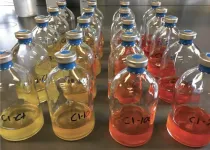(Press-News.org) May 26, 2021, CLEVELAND: According to new findings published in Science Translational Medicine, Cleveland Clinic researchers have identified a promising drug target for treating and preventing aggressive, drug-resistant prostate cancer.
The team, led by Nima Sharifi, M.D., of Cleveland Clinic's Lerner Research Institute, demonstrated that inhibiting the protein H6PD led to significantly reduced tumor sizes and improved survival among mouse models with drug-resistant prostate cancer. The H6PD levels also were elevated in biopsied patient tumors, suggesting the protein might be targeted in patients for treatment.
"New treatment approaches for drug-resistant prostate cancer are desperately needed," said Dr. Sharifi, director of Cleveland Clinic's Genitourinary Malignancies Research Center. "These findings suggest an entirely new strategy for treatment of men with this aggressive form of prostate cancer."
Enzalutamide, a current standard-of-care hormone therapy for metastatic prostate cancer, works by blocking androgen receptors, which are proteins that help drive cancer cells. While initially effective, most patients eventually develop resistance to the treatment. This resistance occurs when androgen receptors are blocked and cancer cells adapt to get their "fuel" from a similar receptor, called the glucocorticoid receptor.
These glucocorticoid receptors bind to and interact with the stress hormone cortisol. In an earlier study published in eLife, Dr. Sharifi and his team linked enzalutamide resistance to increased tumor cortisol levels. They found that tumors typically express a protein called 11β-HSD2, which inactivates cortisol. However, when this protein expression is inhibited in some tumors, cortisol and the glucocorticoid receptor are stimulated and become available for use by cancer cells.
"Taken together, our study findings suggest that pharmacologically inhibiting the H6PD protein can reverse drug resistance in prostate cancer cells," said Dr. Sharifi. "By blocking this protein, we are able to prevent cancer cells from utilizing their backup fuel supply - cortisol and its receptor. When we block this pathway, tumors begin to become responsive to standard treatments again."
In this new study, the researchers demonstrated that, in addition to decreased expression of 11β-HSD2, resistant tumors also have increased H6PD levels.
"With lower levels of 11β-HSD2, which normally functions to cut off the fuel supply to drug-resistant cancer cells, the cells are free to continue to grow and spread unchecked," said Dr. Sharifi. "By inhibiting the H6PD protein, however, we were able to reinstate anti-cortisol effects. This finding is key to better understanding how disruptions in cortisol metabolism contribute to cancer cells' growth and spread."
Dr. Sharifi's clinical collaborator Eric Klein, M.D., chair of Cleveland Clinic's Urology & Kidney Institute and a co-author on the study, said, "We found elevated levels of H6PD in both animal models and patient tissues, particularly after treating tumors with enzalutamide. These findings hold promise for novel precision medicine approaches in the management of men with aggressive prostate cancer."
The researchers targeted H6PD with rucaparib, a drug already approved by the U.S. Food and Drug Administration. Dr. Sharifi collaborated with scientists from Cleveland Clinic's Center for Therapeutics Discovery to identify what parts of rucaparib are chemically necessary to inhibit the protein.
Researchers administered enzalutamide to mouse models of aggressive prostate cancer that expressed H6PD and those where the protein was blocked with rucaparib. The models where H6PD was blocked had significantly smaller tumors and longer progression-free survival following enzalutamide treatment.
INFORMATION:
Jianneng Li, PhD, a post-doctoral fellow in Dr. Sharifi's lab, is first author on the study, which was supported by the National Cancer Institute and the Prostate Cancer Foundation.
About Cleveland Clinic
Cleveland Clinic is a nonprofit multispecialty academic medical center that integrates clinical and hospital care with research and education. Located in Cleveland, Ohio, it was founded in 1921 by four renowned physicians with a vision of providing outstanding patient care based upon the principles of cooperation, compassion and innovation. Cleveland Clinic has pioneered many medical breakthroughs, including coronary artery bypass surgery and the first face transplant in the United States. U.S. News & World Report consistently names Cleveland Clinic as one of the nation's best hospitals in its annual "America's Best Hospitals" survey. Among Cleveland Clinic's 67,554 employees worldwide are more than 4,520 salaried physicians and researchers, and 17,000 registered nurses and advanced practice providers, representing 140 medical specialties and subspecialties. Cleveland Clinic is a 6,026-bed health system that includes a 165-acre main campus near downtown Cleveland, 19 hospitals, more than 220 outpatient facilities, and locations in southeast Florida; Las Vegas, Nevada; Toronto, Canada; Abu Dhabi, UAE; and London, England. In 2019, there were 9.8 million total outpatient visits, 309,000 hospital admissions and observations, and 255,000 surgical cases throughout Cleveland Clinic's health system. Patients came for treatment from every state and 185 countries. Visit us at clevelandclinic.org. Follow us at twitter.com/ClevelandClinic. News and resources available at newsroom.clevelandclinic.org.
Editor's Note: Cleveland Clinic News Service is available to provide broadcast-quality interviews and B-roll upon request.
Milwaukee, May 26, 2021 - A non-opioid based target has been found to alleviate chronic touch pain and spontaneous pain in mice. Researchers at the Medical College of Wisconsin (MCW) discovered that blocking transient receptor potential canonical 5 (TRPC5) activity reversed touch pain in mouse models of sickle cell disease, migraine, chemotherapy-related pain, and surgical pain.
TRPC5 is a protein that is expressed in both mouse and human neurons that send pain signals to the spinal cord. The findings were published in Science Translational Medicine. The senior and co-first authors of the manuscript, respectively, are MCW researchers ...
What if a robot could organize your closet or chop your vegetables? A sous chef in every home could someday be a reality.
Still, while advances in artificial intelligence and machine learning have made better robotics possible, there is still quite a wide gap between what humans and robots can do. Closing that gap will require overcoming a number of obstacles in robot manipulation, or the ability of robots to manipulate environments and adapt to changing stimuli.
Ph.D. candidate Jinda Cui and Jeff Trinkle, Professor and Chair of the Department of Computer Science and Engineering ...
PITTSBURGH, May 26, 2021 - In a paper published today in Science Advances, researchers from the University of Pittsburgh School of Medicine showed that inhalable nanobodies targeting the spike protein of the SARS-CoV-2 coronavirus can prevent and treat severe COVID-19 in hamsters. This is the first time the nanobodies--which are similar to monoclonal antibodies but smaller in size, more stable and cheaper to produce--were tested for inhalation treatment against coronavirus infections in a pre-clinical model.
The scientists showed that low doses of an aerosolized nanobody named Pittsburgh inhalable Nanobody-21 (PiN-21) protected hamsters from the dramatic weight loss ...
An inhalable nanobody-based treatment may effectively prevent and treat SARS-CoV-2 infections when administered at ultra-low doses, according to a new study in Syrian hamsters. This novel therapy, Pittsburgh inhalable Nanobody 21 (PiN-21), could provide an affordable, needle-free alternative to monoclonal antibodies for treating early infections. Sham Nambulli and colleagues recently developed PiN-21, which uses single-domain antibody fragments that are cheaper to produce than monoclonal antibodies. However, until this study, the efficacy of PiN-21 had not been reported in living organisms. To advance the development of this treatment, Nambulli et al. administered a 0.6 milligram per kilogram ...
Piscine orthoreovirus (PRV) - which is associated with kidney and liver damage in Chinook salmon - is continually being transmitted between open-net salmon farms and wild juvenile Chinook salmon in British Columbia waters, according to a new genomics analysis published today in Science Advances.
The collaborative study from the University of British Columbia (UBC) and the Strategic Salmon Health Initiative (SSHI) -- a partnership between Fisheries and Oceans Canada (DFO), Genome BC and the Pacific Salmon Foundation -- traces the origins of PRV to Atlantic salmon farms in Norway and finds that the virus is now almost ubiquitous in salmon farms in B.C.
It also shows that wild Chinook salmon are more likely to be infected with ...
Jodi Karnell and colleagues have developed a monoclonal antibody, VIB7734, that reduces symptom severity in people with cutaneous lupus by targeting and depleting plasmacytoid dendritic cells (pDC) in blood and skin. In two phase I clinical trials involving a total of 67 people with autoimmune diseases such as lupus, treatment with VIB7734 was as safe as a placebo and significantly reduced pDC frequencies, the researchers found. The antibody also reduced the activity of a group of key immune proteins called type 1 interferons in skin. Both pDCs and type 1 interferons are suspected ...
In the human gut, good bacteria make great neighbors.
A new Northwestern University study found that specific types of gut bacteria can protect other good bacteria from cancer treatments -- mitigating harmful, drug-induced changes to the gut microbiome. By metabolizing chemotherapy drugs, the protective bacteria could temper short- and long-term side effects of treatment.
Eventually, the research could potentially lead to new dietary supplements, probiotics or engineered therapeutics to help boost cancer patients' gut health. Because chemotherapy-related microbiome changes in children are ...
MOSCOW, Idaho -- May 26, 2021 -- University of Idaho researchers partnered with other scientists from the United States and Australia to study the evolution of Tasmanian devils in response to a unique transmissible cancer.
The team found that historic and ongoing evolution are widespread across the devils' genome, but there is little overlap of genes between those two timescales. These findings, published in Proceedings of the Royal Society B, suggest that if transmissible cancers occurred historically in devils, they imposed natural selection on different sets of genes.
Tasmanian devils suffer from a transmissible cancer called devil facial tumor disease (DFTD). Unlike typical cancers, tumor cells from transmissible cancers are directly transferred from one individual ...
Children of Latinx immigrants who take on adult responsibilities exhibit higher levels of political activity compared with those who do not, according to University of Georgia researcher Roberto Carlos.
Immigrant communities often display low levels of political engagement, but a new study by Carlos indicates that when children of Latinx immigrants take on adult roles because of parents' long work hours, immigrant status or language deficiencies, they develop noncognitive skills associated with higher rates of political participation.
"There is thriving in spaces that we wouldn't necessarily expect because of the hardship related ...
"If you can't measure it, you can't improve it". This concept is also true within the context of climate policy, where the achievement of the objectives of the United Nations Framework Convention on Climate Change (UNFCCC) is dependent on the ability of the international community to accurately measure greenhouse gas (GHG) emission trends and, consequently, to alter these trends.
Greenhouse gas (GHG) emission inventories represent the link between national and international political actions on climate change, and climate and environmental sciences. Research communities and inventory agencies have approached the problem of climate ...



